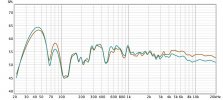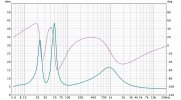- Joined
- Aug 12, 2022
- Messages
- 355
- Likes
- 347
These are 2 measurements of the same speaker from the same spot. One is with a Tubes4hif ST120 and the other is a Parasound Zamp V3. Why does the tube amp have 2db less treble above 3KHz. I know that the Parasound measurement is more accurate since it measures the same as my Buckeye Class D amp. Are my tubes going bad in the tube amp and losing treble?


